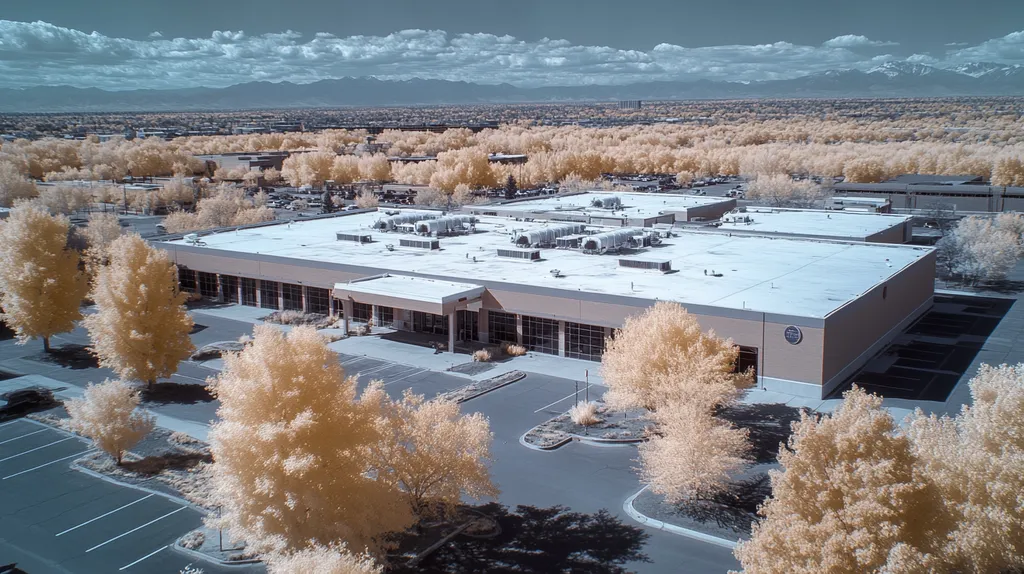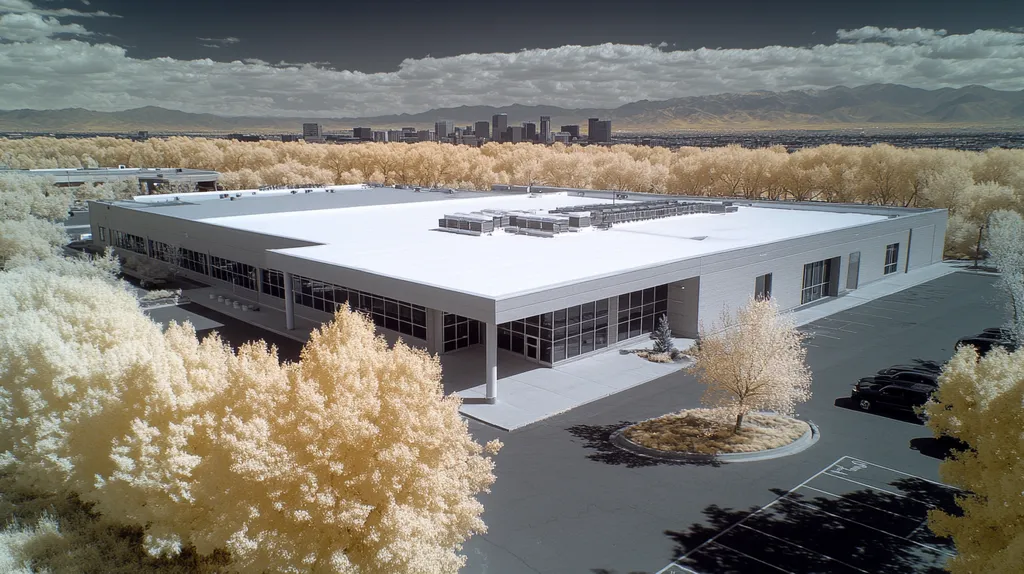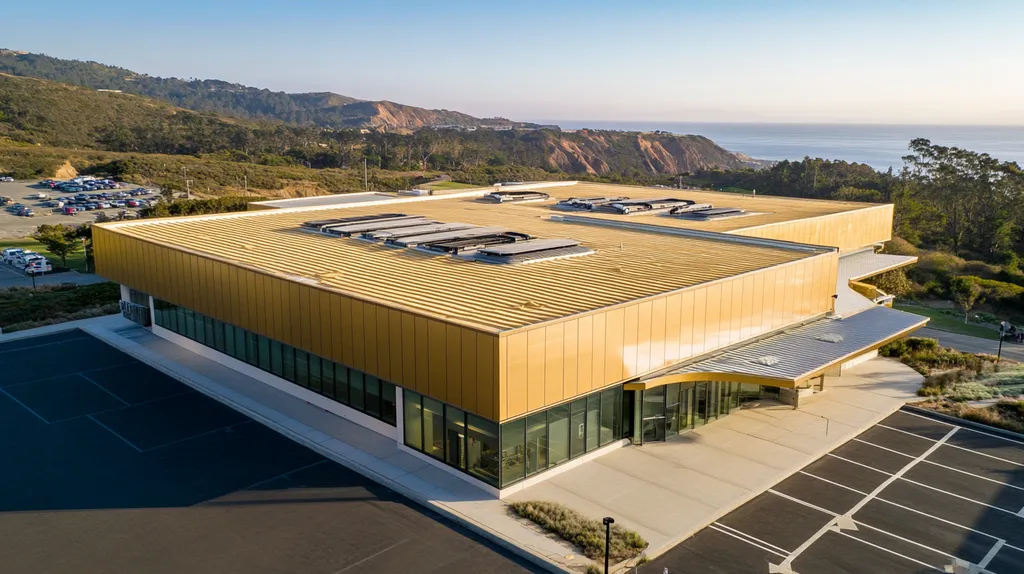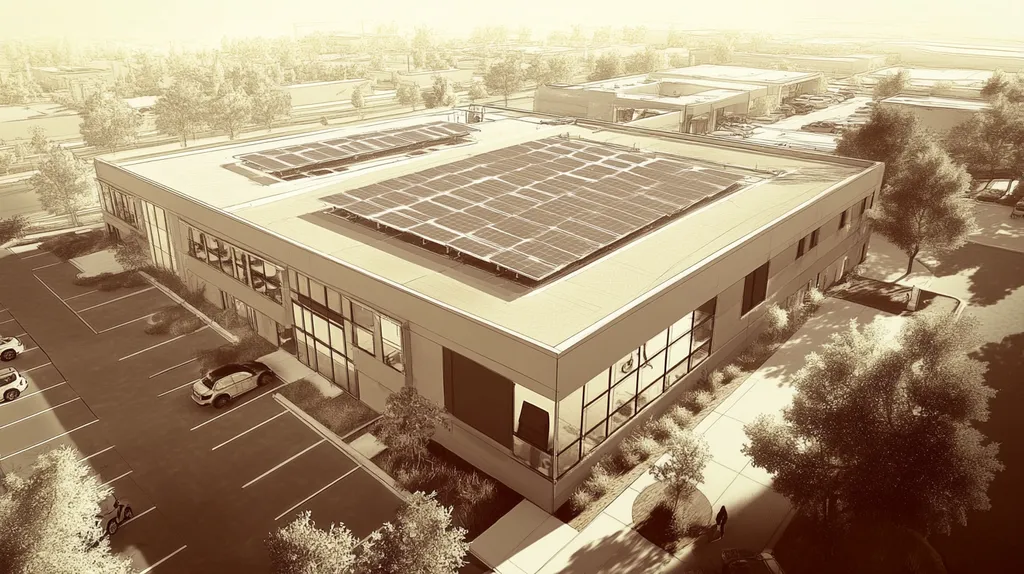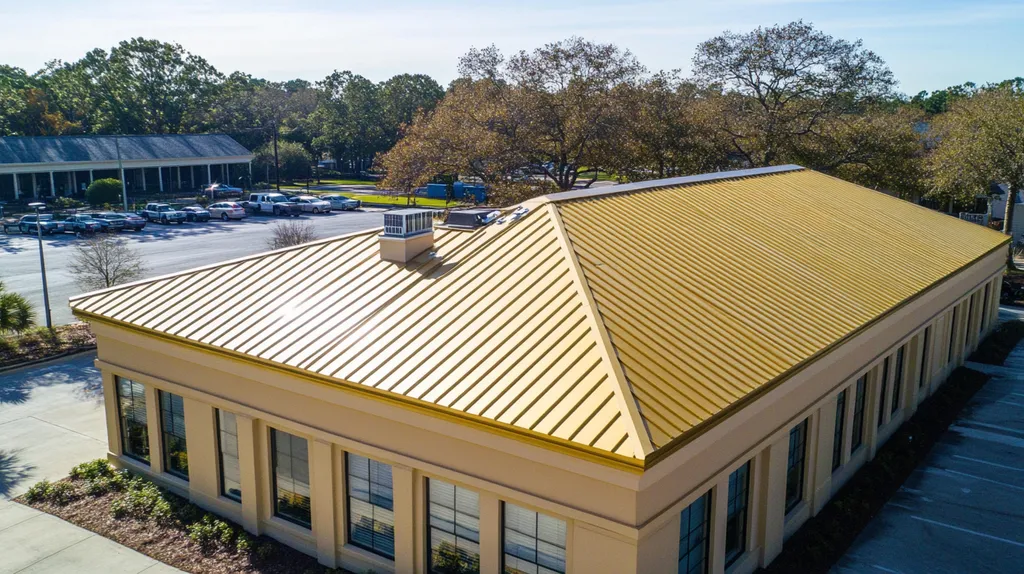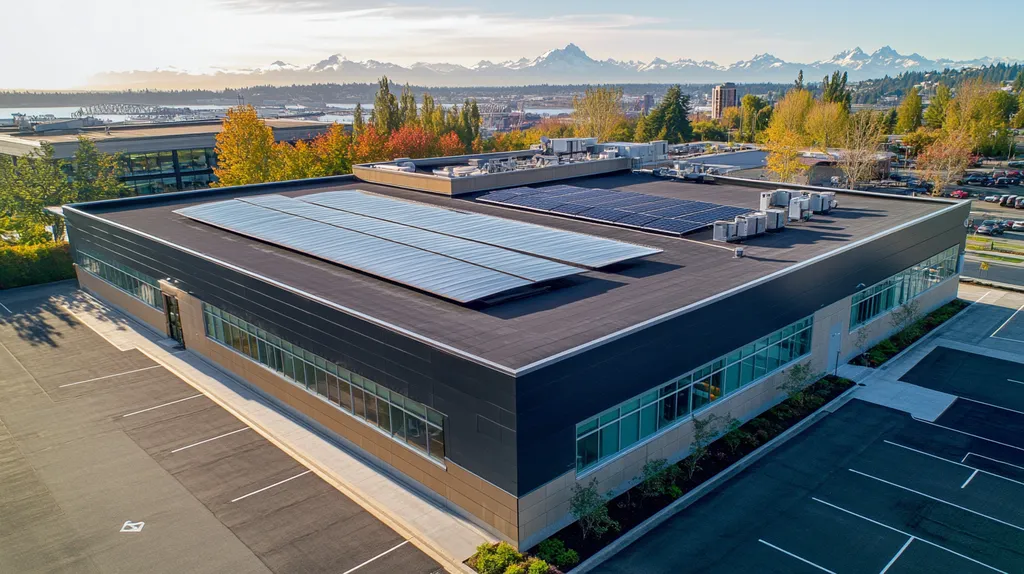Rising energy costs are forcing industrial facilities to rethink their roofing strategies. With cooling expenses representing up to 40% of building energy consumption, roof reflectivity has emerged as a critical factor in operational efficiency.
Studies show that highly reflective industrial roofs can reduce peak cooling demand by 15-25% while extending HVAC equipment life. Yet over 75% of commercial buildings still use traditional dark roofing materials that absorb rather than reflect heat.
This comprehensive guide examines the science behind roof reflectivity, its practical applications, and how facility managers can leverage this technology to dramatically reduce energy costs.
SECTION 1: THE BASICS EXPLAINED
Industrial roofing decisions have never been more critical for facility operations and bottom lines. With energy costs soaring and environmental regulations tightening, roof reflectivity has emerged as a key factor in building efficiency. Nearly 75% of commercial buildings in the U.S. still use traditional dark roofing materials that absorb rather than reflect heat, leading to excessive cooling costs and accelerated material degradation.
What It Is (In Plain Language)
Roof reflectivity measures how effectively a roofing surface bounces sunlight back into the atmosphere instead of absorbing it as heat. Cool roofs are specifically designed to reflect more sunlight and absorb less solar energy, which directly impacts building temperature. (source: U.S. Department of Energy)
Think of reflectivity as your roof’s natural cooling system. The higher the reflectivity rating, the less heat enters your building through the roof surface, reducing the strain on your HVAC systems.
Modern reflective roofing materials use specialized pigments and coatings to achieve optimal performance. These materials can reflect up to 80% of incoming solar radiation, compared to traditional dark surfaces that might only reflect 20%.
The industry measures reflectivity using the Solar Reflectance Index (SRI), which ranges from 0 to 100. Higher numbers indicate better reflection capabilities, helping facility managers compare different roofing options.
Why It Matters (To Your Building)
The financial impact of roof reflectivity is immediate and significant. Buildings with highly reflective roofs typically see cooling cost reductions of 15-30% during peak summer months, translating to substantial annual savings.
Reflective roofs also protect your building’s structural integrity. Lower surface temperatures mean less thermal expansion and contraction, which reduces stress on roofing materials and extends their lifespan.
For facilities operating sensitive equipment or maintaining specific temperature requirements, reflective roofing provides more stable internal environments. This stability reduces equipment strain and maintenance needs.
Environmental benefits extend beyond individual buildings. Reflective roofs help combat urban heat island effects, potentially reducing local air temperatures by several degrees during summer peaks.
How It Works
Solar radiation hits your roof in three primary forms: ultraviolet, visible light, and infrared. Reflective roofing materials are engineered to bounce back as much of this energy as possible before it converts to heat.
The process relies on both surface properties and material composition. Light-colored surfaces naturally reflect more visible light, while specialized materials and coatings handle infrared radiation effectively.
Temperature differences between reflective and traditional roofs can exceed 50°F during peak summer conditions. This dramatic difference occurs because reflective surfaces immediately bounce back solar energy rather than allowing it to penetrate the building.
Advanced reflective materials maintain their performance even as they age, thanks to new technologies in dirt resistance and surface stability. Regular maintenance can help preserve these reflective properties over the roof’s lifetime.
SECTION 2: PRACTICAL APPLICATIONS
Industrial facilities across North America waste millions in energy costs annually due to inadequate roof reflectivity. With cooling expenses representing up to 40% of commercial building energy usage, choosing the right reflective roofing solution has become a critical business decision. Strategic implementation of reflective roofing systems can reduce peak cooling demand by 15-25% while extending HVAC equipment life and improving indoor comfort.
Common Uses & Examples
Manufacturing facilities, warehouses, and distribution centers represent prime candidates for reflective roofing applications. These large-footprint buildings often struggle with excessive heat buildup and astronomical cooling costs during peak summer months.
Modern reflective solutions include single-ply membranes like TPO and PVC, as well as specialized coating systems that can be applied to existing roofs. These materials achieve optimal performance through engineered surface properties that maximize solar reflection.
Food processing facilities and cold storage warehouses particularly benefit from reflective roofing, as stable interior temperatures are crucial for product quality and storage compliance. Many of these facilities report 20-30% reductions in refrigeration costs after installing reflective systems.
Distribution centers with high-bay storage areas see dramatic improvements in worker comfort and productivity. The reduced heat load allows facilities to maintain consistent temperatures even in top-level storage areas that traditionally suffer from extreme heat.
When You Need It Most
Reflective roofing delivers maximum benefit in facilities with high cooling demands or sensitive temperature requirements. Buildings in southern climates or urban heat islands often see the most dramatic energy savings.
A high solar reflectance is particularly crucial for buildings with large roof areas relative to their overall size. Single-story industrial facilities typically fall into this category, making them ideal candidates for reflective solutions. (source: US EPA)
Facilities operating heat-generating equipment or processes should prioritize reflective roofing to offset internal heat loads. This includes manufacturing operations, data centers, and industrial kitchens where equipment heat compounds summer cooling challenges.
Peak energy demand periods – typically afternoon hours during summer months – represent critical times when reflective roofing provides the greatest operational savings through reduced cooling load.
Interactions With Other Systems
Reflective roofing works synergistically with proper insulation to create a comprehensive thermal barrier. While reflective surfaces reject incoming solar heat, insulation prevents internal temperature transfer, maximizing overall system efficiency.
HVAC systems benefit directly from reduced heat load, operating more efficiently and requiring less maintenance. Many facilities can downsize cooling equipment or extend its service life when installing reflective roofing.
Rooftop solar installations perform better when mounted on reflective surfaces, as lower ambient temperatures improve photovoltaic efficiency. This dual benefit makes reflective roofing particularly attractive for facilities considering solar energy.
Building automation systems can leverage the predictable performance of reflective roofing to optimize HVAC operation. Smart controls can anticipate cooling needs based on solar load, further enhancing energy savings.
SECTION 3: KEY TERMINOLOGY DECODED
The language barrier between roofing professionals and facility managers costs industrial buildings millions in wasted energy annually. When decision-makers misunderstand technical specifications, they often select materials that underperform or fail to meet efficiency goals. Studies show that proper interpretation of roofing terminology can lead to 20-30% better energy performance through informed material selection.
Essential Terms Explained
Solar reflectance represents your roof’s ability to bounce sunlight back into the atmosphere rather than absorbing it as heat. The measurement ranges from 0 to 1, with higher numbers indicating better reflection.
Thermal emittance measures how efficiently your roof releases any heat it does absorb. Even highly reflective surfaces absorb some heat, making this second line of defense crucial for temperature control.
The Solar Reflectance Index (SRI) combines both reflectance and emittance into a single score. This unified measurement makes it easier to compare different roofing materials and their potential impact on building temperature.
Cool roofs employ specialized materials and coatings to achieve high SRI scores. These systems can maintain surface temperatures up to 50°F cooler than traditional dark roofs during peak summer conditions.
Industry Jargon Translated
A high solar reflectance, or albedo, indicates superior heat reflection capabilities. This characteristic proves most critical for reducing cooling costs and extending roof lifespan. (source: US EPA)
R-value measures insulation effectiveness, working alongside reflectivity to control internal temperatures. Higher R-values indicate better resistance to heat flow through the roof structure.
Initial solar reflectance refers to a new material’s performance, while aged solar reflectance indicates effectiveness after three years of weathering. This distinction helps predict long-term energy savings.
Cool roof certification programs provide standardized performance metrics. These third-party validations ensure materials meet minimum reflectance and emittance requirements for energy efficiency.
Measurement & Units Simplified
Solar reflectance measurements use a 0-1 scale, where 0 indicates total absorption and 1 represents perfect reflection. Most high-performance cool roofs achieve ratings between 0.65 and 0.85.
Thermal emittance follows the same 0-1 scale. Quality roofing materials typically maintain emittance values above 0.75, ensuring efficient heat release.
The SRI scale ranges from 0 to 100, with standard black surfaces scoring 0 and standard white surfaces rating 100. Modern cool roof systems often achieve SRI values above 78.
Temperature reduction potential measures actual cooling impact in degrees. This practical measurement helps facility managers calculate potential HVAC savings based on local climate conditions.
SECTION 4: DECISION FACTORS
Industrial facility owners face critical decisions about roofing systems that impact both immediate operations and long-term building performance. With energy costs representing up to 30% of operational expenses, choosing the right reflective roofing solution has become a strategic imperative. Studies show that improper roofing decisions can increase cooling costs by up to 40% while accelerating material degradation, making informed selection essential for operational efficiency.
Cost Considerations
Initial investment in reflective roofing typically runs 10-15% higher than traditional dark materials. However, energy savings of 15-25% annually make the payback period remarkably short, often less than three years in warm climates.
Many utilities and local governments offer substantial incentives for reflective roofing installations. These programs can offset 20-40% of material costs while accelerating return on investment through reduced energy expenses.
Maintenance costs decrease significantly with reflective systems due to reduced thermal stress. Most facilities report 30-50% lower repair expenses over the roof’s lifetime compared to conventional materials.
Property values typically increase 5-10% with high-performance reflective roofing installations, making them attractive for both current operations and future resale considerations.
Performance Trade-offs
A high solar reflectance provides maximum benefit in cooling-dominated climates but may slightly increase heating costs in northern regions. The net energy savings remain positive in most applications, with summer cooling benefits outweighing winter heating penalties. (source: U.S. Environmental Protection Agency)
Material thickness and durability often correlate inversely with reflectivity. Thinner, highly reflective membranes may require additional insulation or structural support to match the performance of traditional systems.
Surface appearance changes over time as reflective materials weather and accumulate dirt. Regular cleaning can maintain 80-90% of initial reflectivity, while neglected surfaces may lose up to 30% of their reflective capability.
Installation complexity varies significantly between different reflective systems. Some require specialized equipment and trained installers, potentially limiting contractor options and affecting installation schedules.
Lifespan & Durability Factors
Modern reflective roofing systems typically last 20-30 years when properly installed and maintained. This longevity matches or exceeds traditional roofing materials while delivering superior energy performance throughout the service life.
Environmental factors significantly impact durability. UV exposure, precipitation patterns, and temperature fluctuations all affect material degradation rates, making climate-appropriate selection crucial for maximum lifespan.
Warranty coverage varies widely between manufacturers and systems. Premium reflective materials often carry 20-year warranties covering both materials and performance, providing important risk protection for facility owners.
Installation quality directly affects system longevity. Proper seam welding, flashing details, and drainage design can extend service life by 25-40% compared to standard installation practices.
Regular inspections and maintenance programs help identify potential issues before they compromise system performance. Most manufacturers recommend semi-annual inspections to maintain warranty coverage and optimize reflective properties.
SECTION 5: COMMON CHALLENGES
Industrial facility managers face mounting pressure to optimize their roofing systems for energy efficiency, but implementation challenges threaten to undermine these efforts. Studies show that up to 40% of reflective roofs underperform due to preventable issues like improper maintenance, poor installation, and material degradation. Without proper attention to these challenges, facilities risk losing millions in energy savings while shortening their roof’s functional lifespan.
Frequent Problems & Solutions
Reflective roof membranes now dominate the industrial roofing sector, accounting for over 50% of new installations. These systems consistently demonstrate reduced cooling loads and significant energy savings across diverse climate zones. (source: Buildings Journal)
Surface contamination poses the most immediate threat to performance. Dirt, pollution, and organic growth can reduce reflectivity by up to 35% within the first year if left unchecked, making regular cleaning essential for maintaining energy benefits.
Installation defects create both immediate and long-term problems. Poor seam welds, improper flashing, and inadequate drainage design can compromise system integrity while reducing energy performance.
Material compatibility issues often emerge when repairs or modifications are needed. Using non-compatible sealants or patches can degrade reflective surfaces and create weak points in the system.
Warning Signs To Watch For
Visual indicators provide early warning of developing problems. Discoloration, surface chalking, and membrane deterioration signal declining reflective performance that will impact energy efficiency.
Changes in interior comfort levels often indicate roofing issues. Areas that become harder to cool or show increased temperature fluctuations may point to compromised reflective properties.
Standing water after rainfall suggests drainage problems that can accelerate material degradation. Even small ponding areas can reduce reflectivity and create conditions for biological growth.
Rising energy costs, particularly during peak cooling seasons, may indicate declining roof performance. Track cooling expenses monthly to identify trends that could signal reflectivity issues.
Preventative Approaches
Scheduled maintenance programs significantly extend reflective roof performance. Quarterly inspections and semi-annual cleaning preserve reflective properties while identifying potential issues early.
Data-driven monitoring helps optimize maintenance timing. Track energy usage patterns, interior temperatures, and weather conditions to identify when interventions will deliver maximum benefit.
Professional training for facility staff improves daily oversight. Teaching maintenance teams to recognize warning signs and document changes enables faster response to developing issues.
Strategic timing of repairs and replacements maintains system integrity. Schedule major work during moderate weather conditions to ensure proper material curing and adhesion.
Documentation of all maintenance activities creates valuable performance history. These records help identify patterns, predict future needs, and justify investments in preventative measures.
SECTION 6: NEXT STEPS & RESOURCES
Industrial facility managers face mounting pressure to optimize roofing systems as energy costs continue to rise. With cooling expenses representing up to 40% of building energy consumption, selecting and implementing the right reflective roofing solution has become mission-critical. Yet many facilities struggle to navigate technical specifications, installation requirements, and maintenance protocols that directly impact performance.
Questions To Ask Providers
Start by requesting detailed Solar Reflectance Index (SRI) ratings for all proposed materials. Leading providers should offer documentation showing both initial and three-year aged reflectivity values to help predict long-term performance.
Demand specifics about installation methods and quality control processes. Proper installation directly impacts energy performance, so providers should detail their techniques for seam welding, flashing installation, and drainage design.
Request verification of energy savings through modeling or case studies. Quality providers will demonstrate projected savings based on your facility’s specific characteristics, local climate conditions, and utility rates.
Discuss maintenance requirements and support services upfront. Understanding cleaning protocols, inspection schedules, and repair procedures helps ensure optimal reflectivity throughout the roof’s lifespan.
Industry Standards & Guidelines
Cool roofs represent a proven strategy for reducing building energy consumption and lowering internal temperatures. These systems reflect more sunlight and absorb less solar energy than conventional roofing, creating significant operational savings. (source: Department of Energy)
The Cool Roof Rating Council (CRRC) provides independent performance ratings for roofing products. Their Product Rating Program measures both initial and aged solar reflectance, helping facility managers compare options objectively.
ASTM International publishes critical test methods and specifications for reflective roofing. Standards like ASTM E1980 establish consistent procedures for calculating Solar Reflectance Index values across different materials.
Local building codes increasingly include minimum reflectivity requirements. Many jurisdictions now mandate specific SRI values for commercial roofing, making compliance verification essential during material selection.
Further Learning Simplified
Major roofing manufacturers offer technical bulletins and design guides focused on reflectivity. These resources typically include specification tools, installation guidelines, and maintenance recommendations specific to their systems.
Industry associations provide valuable educational resources through webinars and online training modules. These programs often feature case studies demonstrating successful implementations across different facility types.
Professional certification programs help facility teams develop expertise in reflective roofing systems. Organizations like RCI and NRCA offer targeted courses covering material selection, installation oversight, and maintenance protocols.
Regional energy efficiency organizations frequently host workshops addressing industrial roofing strategies. These events provide networking opportunities while showcasing latest technologies and best practices.
The Bottom Line
With energy costs continuing to rise 8-12% annually, industrial facilities can no longer afford to ignore roof reflectivity as a critical efficiency factor.
Studies demonstrate that highly reflective industrial roofs reduce cooling costs by 15-25% while extending HVAC equipment life by up to 7 years.
Yet over 75% of commercial buildings still use traditional dark roofing materials that absorb rather than reflect heat, leading to millions in preventable energy waste.
The technology, materials, and expertise now exist to dramatically improve building efficiency through optimized roof reflectivity.
Facility managers who act decisively to implement reflective roofing solutions position their operations for significant competitive advantages in an era of increasing energy challenges.
FREQUENTLY ASKED QUESTIONS
Q. What is reflectivity for commercial roof materials?
A. Reflectivity measures how well roofing materials bounce sunlight away instead of absorbing heat. Higher reflectivity ratings reduce indoor heat, leading to lower cooling costs and improved energy efficiency for your building.
Q. How can an industrial roof reduce energy costs?
A. An industrial roof with reflective materials can lower cooling costs by 15-25%. This reduction improves overall energy consumption, making the building more environmentally friendly while saving money on utility bills.
Q. What does SRI mean for commercial roofs?
A. The Solar Reflectance Index (SRI) combines reflectivity and thermal emittance into a singular score. It helps facility managers compare roofing materials, with higher values indicating better energy performance and potential cooling savings.
Q. How long do reflective materials last on industrial roofs?
A. Reflective roofing systems generally last 20-30 years when properly maintained. Their durability can match or even exceed traditional roofing, providing ongoing energy savings throughout their service life.
Q. What can hinder energy efficiency in industrial roofs?
A. Issues like surface contamination, poor installation, and material degradation can significantly reduce a roof’s energy efficiency. Regular maintenance and professional installation are crucial to avoid these challenges and maximize energy savings.
Q. What questions should I ask roofing providers?
A. Inquire about SRI ratings, installation methods, and energy savings projections. This information ensures you understand the performance potential and maintenance requirements of the reflective roofing materials being proposed.
Q. How do I maintain my commercial roof’s reflectivity?
A. Regular cleaning and schedule inspections are vital to maintain a roof’s reflectivity. Keeping the surface free from dirt and debris ensures that the reflective properties remain effective, maximizing energy efficiency and performance.

